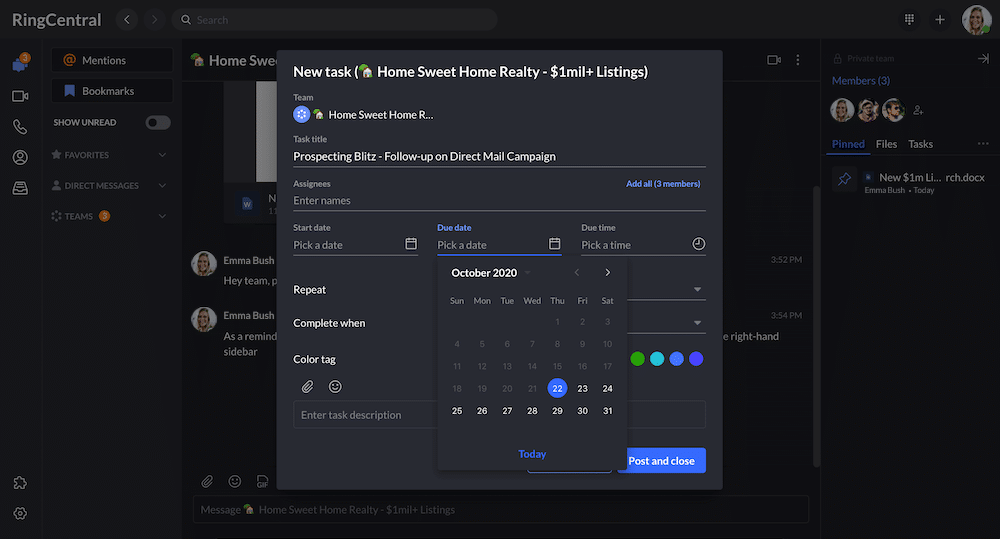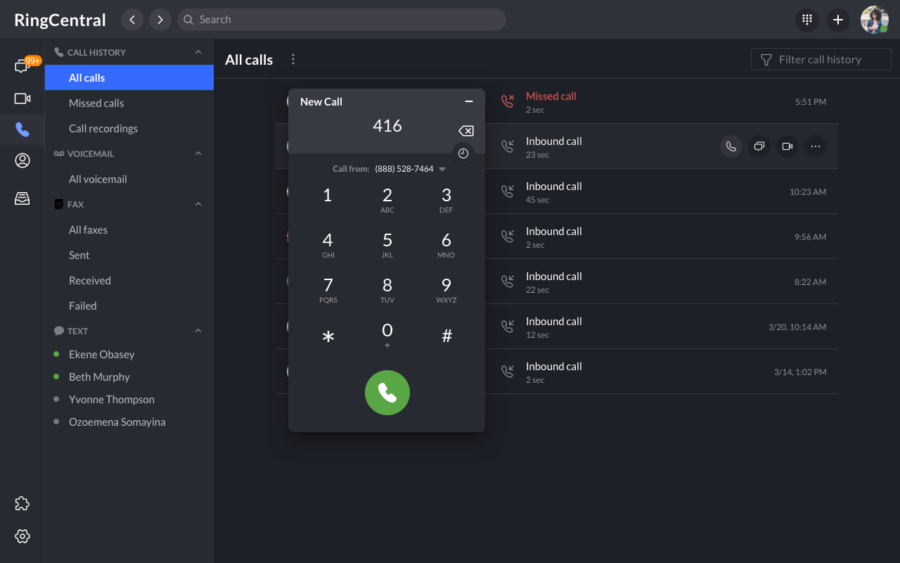A business continuity plan is one of the most important documents that a small business will draw up. Known as a BCP for short, this document outlines how a business will maintain its critical functions in case of disruption.
Despite its importance, 75% of small businesses have no disaster recovery plan objective in place. Considering that an incredible 93% of companies without a plan in place go out of business within a year after a major data disaster, this is, to put it lightly, a big problem.
It’s tempting to think that you won’t encounter any disasters or emergencies, but events like the COVID-19 outbreak have shown that’s not the case. Businesses in every industry, both large and small, have had to call upon their business continuity plans to survive. Those with remote communication solutions already in place, by and large, have found it much easier to bounce back.
We’ll show you how to build your own business continuity plan below by using a free template we’ve created for you—it’s editable and you can customize it easily. Grab it here and use it to follow along later:
✍️ Want to start making a plan for your business—just in case? Download this free business continuity plan template.
With this in mind, it’s vital to have a BCP in place and to understand what kind of emergency events to prepare for. Here are a few examples of possible disruptions that you’ll need a plan for:
- On-site emergencies, like fires or floods
- Natural disasters
- Cyber attacks
- Utility or hardware failures
- Economic downturns
- Supply shortages
Read on to find out the core elements of a good business continuity plan and how to make sure your small business has the right foundations for any situation. We’ll cover:
- What is continuity in a business?
- What is a business continuity plan template?
- The 3 key elements in a business continuity plan template
- How do you write a business continuity plan template?
- Frequently asked questions
What exactly is continuity in a business?
All businesses rely on continuity for success. Business continuity is simply the process of maintaining essential business functions at all times, no matter the situation. Achieving this continuity takes a lot of planning—and the successful execution of those plans should the worst happen.
No matter how small your business is, business continuity planning is one of the most important things you can do to protect it. A good BCP will establish strategic risk-management procedures to be carried out before, during, and after unforeseen disruptions. It should help mitigate the impact of disruptions on your business’s mission-critical services and reduce revenue loss. That way, your business can get back to full functionality quickly.
Nobody knows the future. Since we cannot anticipate every challenge a business is going to face, any BCP you create needs to be speculative by nature. To draw up a comprehensive BCP, you need to be able to consider a wide range of unpredictable events.
With a well thought out business continuity plan in place, your business will be able to allocate budgets appropriately across mission-critical functions and mobilize failover mechanisms when the waters get rough.
Is business continuity the same as disaster recovery?
The idea of business continuity can sometimes be confused with disaster recovery. But, business continuity and disaster recovery procedures are not the same thing—disaster recovery is just one subset of business continuity planning.
Both processes will help your business plan for continued procedures in times of disaster. A disaster recovery plan is designed to restore a business’s essential functions after a disruption takes place. That could mean restoring IT systems, hardware systems, and other assets with the intention of minimizing downtime and getting operations back to normal quickly.
In contrast, business continuity planning includes efforts to devise a clear plan of action beyond just getting your technology back up and running. It includes things like a clear outline of what kinds of processes and operations are at risk, who’s in charge of keeping the business going, a communications plan, and more. A business continuity plan details the steps that need to be mobilized as soon as unexpected disruption occurs to help businesses run at as close to normal capacity as possible. It might also include risk management and preventive strategies.
What is a business continuity plan template?
A business continuity plan template helps business continuity managers, small business owners, and IT teams outline their strategies. In other words, it is a framework from which a business continuity plan can be devised.
If you’re not sure how to start your BCP, a template is a great place to start. It will help you identify areas of high impact and plan accordingly. These areas might be:
- Assets
- Recovery strategy
- Assigned personnel
- Scope and objectives
- Operations at risk
- Roles and responsibilities
There are business continuity templates available for different businesses, across all industries, facing their respective challenges. Some might focus on IT recovery, others on customer operations, and others on transport and logistics.
There are lots of plans available online, so identify your particular industry needs and pick one accordingly. If you’re looking for one, here’s a free business continuity plan template we created for small businesses that want to get a head start on planning. You can grab it here:
The 3 key elements of a business continuity plan template
A standard business continuity plan can be broken down into three key elements: resilience, recovery, and contingency.
Every one of these elements is essential if you want your BCP to be effective in practice. Let’s take a closer look at each in turn.
1. Is your business as resilient as it could be?
First off, businesses need to give themselves the foundations for resilience. You can increase the resilience of your business by designing potential disaster situations in mind. Be prepared is key to making sure your critical functions and essential infrastructure can withstand a multitude of possible challenges.
Things to keep in mind when planning for resilience:
- Staffing rotations
- Data redundancy
- Surplus capacity
- Emergency contacts
- Potential security risks
- Essential equipment
- Alternative facilities
Investing in software that can see you through a crisis is important, but to really benefit, you need to familiarize yourself with it in advance. This improves resilience as your staff can continue as normal, rather than scrambling to learn something new.
Communications software is particularly vital, as communication is the foundation for all other strategies. For example, having a cloud phone system in place means that, if your staff suddenly have to change offices or switch to remote or hybrid work, they can still work together from anywhere, uninterrupted.
This way, you’re not completely dependent on landlines or deskphones in your office, and your team can work from both their phones and computers:
It also means your customers or clients will always know how they can get in touch with you, allowing you to maintain normal business operations as much as possible.
2. Is your business set for a quick recovery?
We’ve already talked about how important a business continuity plan is for ensuring a fast recovery after any disruption to your usual day-to-day work. When something goes wrong, you’re going to want to resume full business functionality as soon as possible.
A rapid recovery means less money lost, less uncertainty, and less disruption and confusion for your customers. To plan for recovery, set recovery time objectives for your different operations and processes. This helps prioritize which operations are the most important and lets you direct your resources accordingly.
Other strategies to consider include creating dedicated recovery teams, sourcing alternative spaces, and making agreements with third-party businesses to help take on a share of operations in times of need.
3. Does your business have a contingency plan in place?
Contingency planning is an essential step towards protecting your small business from the worst-case-scenario. It sets procedures in place for a range of possible eventualities.
A good contingency plan will mobilize a high chain of command to distribute core responsibilities throughout your organization. When making your contingency plan, consider these essential tasks, and incorporate them into your final document. Important aspects to consider include:
- Hardware replacement
- Damage assessment
- Alternate site vendors (for assistance)
- Leasing emergency office space
- Contacting stakeholders, clients, and customers
How do you write a business continuity plan? (Use the free template above!)
We’ve seen that business continuity planning is important for the security of small businesses. Now it’s time to create the best business continuity plan possible.
Let’s dive in.
Big-picture planning
Before doing anything else, you need to step back and think about big-picture planning. You’re going to need to identify the broader scope of your plan to set sensible, appropriate goals. Think about how much detail you should be going into and get the right people in the room.
The aim of continuity planning is a successful outcome, so be clear about what a successful outcome looks like. Remain focused on that vision throughout the planning process. If you’re not sure where to start, work out how remote ready you are—almost every business needs to have the ability to work away from the office as one of their goals.
Tag your teammates
You can’t save your business from an incumbent disaster alone. You’ll need a trustworthy and competent team around you. And that’s true from the very beginning. Bring together a top team of strategists that will work with you long-term to plan, manage, and deliver your continuity plan.
Luckily, today it’s easier than ever to work collaboratively thanks to all-in-one, internet communications. There are many unified communication platforms out there that allow you to message, video, and call your team from anywhere, on any device. Here’s a quick example of what they tend to look like:
So why not tag your teammates in a group thread? That way it’s simple and easy to keep your team updated from wherever you are with document sharing, check-off tasks, meetings with a click, live collaboration, and integrated apps.
For instance, RingCentral’s desktop and mobile app lets you do all of these things—in one convenient place. Message your team and create tasks for them right within that conversation:

Your business continuity management team will be responsible for implementing and then executing the final plan when the time comes. Scale your team according to the size of your business operations and designate a trusted team leader. Each team will usually need a:
- Business continuity manager
- Assistant manager
- Administrative assistant
These roles should have clear expectations attached and an understanding of what steps they need to take in a crisis. Every team member should have their contact information to ease communication in an emergency situation.
Start planning for critical functions
With your team, start formulating the foundations of your business continuity plan. This is when you’ll want to start identifying your business’s unique, core needs. Make a hierarchy of business functions to decide which processes are the most critical to continued functioning.
A good way to approach this is by asking: which functions would cause the most damage to my company if they collapsed? In other words, what can your organization simply not survive without? For example, if communications are the pillar of your customer service, CCaaS solutions can be deployed in minutes and offer built-in business continuity and disaster recovery.
Things like VoIP internet calling for remote communications, or pre-established relationships with off-site third-party resources can be called on in times of need. Having these foundations in place is the best way to guarantee essential services continue no matter what.
Consider which functions are integral to your business operations, reputation, and revenue. A list of critical functions to consider might look something like this:
- Accounting
- Production
- Service and delivery
- Sales and marketing
- Human resources
- Administration
- Information technology
Business impact analysis
Now it’s time for a business impact analysis. You need to undertake a risk assessment covering any challenges that your company will face in case of serious disruption. That means mitigating any conceivable physical, financial, or operational risks to your company.
A business impact analysis collates these risks so that teams can plan. It involves creating a list of potential risk factors and reviewing each in turn in terms of their potential operational damage.
Possible risk factors include, but aren’t limited to:
- Customer dissatisfaction
- Damage to company reputation
- Regulatory fines
- Reduced sales and/or loss of income
- Data losses
- Equipment damage or theft
- New business delay or loss
- Injury to staff, customers, and clients
Plan
You’ve put in the groundwork and now it’s time to start planning. Your plan needs to be in-depth and comprehensive to offer maximum impact. This is the time to strategize and decide upon actionable steps your team can take in case of an emergency.
Your aim is to prevent, respond, and recover as quickly as possible. Let’s look at some examples of actionable strategies that you could include in your business continuity plan.
Strategies for prevention are those strategies put in place before any disruption occurs. In other words, preventative strategies anticipate worst-case-scenarios and plan for them in advance. Examples of preventative measures include:
- Backup utility providers in case of power outages
- Alternative network resources in case of network failure
- Server and data backups to prevent loss of important data
With the outbreak of COVID-19 in 2020, businesses with remote working solutions already in place had at a huge advantage. And if you haven’t already, then making flexible, online communications part of your business continuity plan is a good move.
Make sure you have a robust communication platform or tool to help you plan for situations in which remote or hybrid working might be necessary with secure cloud communications solutions. This platform should give you multiple options in terms of communication channels. Beyond email, how else can your team get in touch with each other? (Team messaging and video conferencing are a few big ones to consider.)
NADA (National Automobile Dealers Association) did exactly this for their business continuity plan. With the help of RingCentral, NADA was able to transition with ease to remote working solutions as the pandemic hit. Thanks to NADA’s proactive thinking and RingCentral cloud communications, the company did not have to slow down their operations due to the unexpected disruption that hit in 2020.
Response strategies are mobilized in times of emergency, or sudden, unexpected disruption.
- Instructions for each member of the business continuity team
- Evacuation procedures
- Safety protocols
- Staff member communications
Strategies for recovery aim to restore mission-critical business functions after a disruption. This should detail all the actions that need to be taken to keep your business running at a functional level until normal operations can resume.
Train
There’s no use having a plan that nobody knows about. Once you and your team members have written up your BCP, it’s time to share it with your employees. Devise a training curriculum to distribute amongst the continuity management team itself, and your business’s wider workforce.
A training curriculum could include:
- A BCP overview
- Key business goals
- Online orientations
- Tactical exercises
- Mock emergency training
Review
Your plan is almost complete. But don’t fall at the last hurdle. Make sure your BCP goes through a thorough review process. Your needs and requirements will change over time and your plan needs to follow suit.
Review your plan on a regular basis to make sure it’s up to date with your current business processes, needs, and requirements. Get your BCP team together to review each step in light of any new developments.
If you need advice from other folks outside your company, there are business continuity management services that help senior management teams assess their BCPs, identify any gaps, and suggest long-term planning strategies.
FAQs
Why do I need a business continuity plan template?
All businesses need business continuity plans to provide emergency support when unexpected disruptions occur. Your business might be running fine right now, but it’s impossible to anticipate future times of crisis.
Using a business continuity plan template instead of starting from scratch helps you save a ton of valuable time since all you have to do is edit the different sections in the template to fit what your specific business needs.
Do I also need a disaster recovery plan?
Yep. It is always a good idea to pair a business continuity plan with a disaster recovery plan. These two initiatives go hand in hand. A disaster recovery plan is designed to make sure you have critical infrastructure backup in place when disaster strikes. This is key to keeping your business-critical operations running whatever the circumstances may be.
Is my current business continuity plan sufficient?
A business continuity plan needs to be constantly updated as your business scales, grows, and changes. If you already have a BCP in place, that’s great. However, don’t let it make you complacent. Conduct regular reviews and make updates as necessary to ensure your plan continues to offer maximum support.
Originally published Jan 04, 2021, updated Mar 15, 2022







